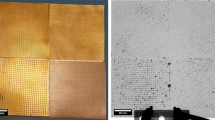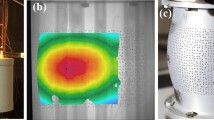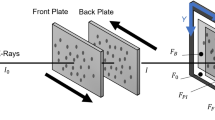Abstract
Background
X-ray imaging addresses many challenges with visible light imaging in extreme environments, where optical diagnostics such as digital image correlation (DIC) and particle image velocimetry (PIV) suffer biases from index of refraction changes and/or cannot penetrate visibly occluded objects. However, conservation of intensity—the fundamental principle of optical image correlation algorithms—may be violated if ancillary components in the X-ray path besides the surface or fluid of interest move during the test.
Objective
The test series treated in this work sought to characterize the safe use of fiber-epoxy composites in aerospace and aviation industries during fire accident scenarios. Stereo X-ray DIC was employed to measure test unit deformation in an extreme thermal environment involving a visibly occluded test unit, incident surface heating to temperatures above 600oC, and flames and soot from combusting epoxy decomposition gasses. The objective of the current work is to evaluate two solutions to resolve the violation of conservation of intensity that resulted from both the test unit and the thermal chamber deforming during the test.
Methods
The first solution recovered conservation of intensity by pre-processing the path-integrated X-ray images to isolate the DIC pattern of the test unit from the thermal chamber components. These images were then correlated with standard, optical DIC software. The second solution, called Path-Integrated Digital Image Correlation (PI-DIC), modified the fundamental matching criterion of DIC to account for multiple, independently-moving components contributing to the final image intensity. The PI-DIC algorithm was extended from a 2D framework to a stereo framework and implemented in a custom DIC software.
Results
Both solutions accurately measured the cylindrical shape of the undeformed test unit, recovering radii values of \(R = 76.20 \pm 0.12\) mm compared to the theoretical radius of \(R_{theor}=76.20\) mm. During the test, the test unit bulged asymmetrically as decomposition gasses pressurized the interior and eventually burned in a localized jet. Both solutions measured the heterogeneous radius of this bulge, which reached a maximum of approximately \(R=91\) mm, with a discrepancy of 2–3% between the two solutions.
Conclusions
Two solutions that resolve the violation of conservation of intensity for path-integrated X-ray images were developed. Both were successfully employed in a stereo X-ray DIC configuration to measure deformation of an aluminum-skinned, fiber-epoxy composite test unit in a fire accident scenario.















Similar content being viewed by others
Data Availibility Statement
Data sets and raw images generated during the current study are available from the corresponding author on reasonable request.
Notes
See Correlated Solution’s documentation for details of these optimization thresholds at https://downloads.correlatedsolutions.com/Vic-3D-9.4-Manual.pdf, accessed 6 Apr 2023.
See MATLAB’s documentation at https://www.mathworks.com/help/vision/ref/triangulate.html, accessed 11 May 2023.
The initial grid of interrogation points was defined with a step size of 3 px, on either the experimental reference image for Cam0 for Solution 1, or in the synthetic “flat” reference image for Solution 2. Due to the curvature of the test unit, a constant step size of 3 px resulted in fewer data points for Solution 1 (5225) compared to Solution 2 (5628).
References
Schreier H, Orteu JJ, Sutton MA (2009) Image correlation for shape, motion and deformation measurements. Springer, US,. https://doi.org/10.1007/978-0-387-78747-3
Raffel M, Willert CE, Scarano F, Kähler CJ, Wereley ST, Kompenhans J (2018) Particle image velocimetry, 3rd edn. Springer International Publishing AG. https://doi.org/10.1007/978-3-319-68852-7
Jones EMC, Reu PL (2017) Distortion of digital image correlation (DIC) displacements and strains from heat waves. Exp Mech 58(7):1133–1156. https://doi.org/10.1007/s11340-017-0354-3
Lynch KP, Jones EMC, Wagner JL (2020) High-precision digital image correlation for investigation of fluid-structure interactions in a shock tube. Exp Mech 60(8):1119–1133. https://doi.org/10.1007/s11340-020-00610-8
Smith CM, Hoehle MS (2018) Imaging through fire using narrow-spectrum illumination. Fire Technol 54:1705–1723. https://doi.org/10.1007/s10694-018-0756-5
Abotula S, Heeder N, Chona R, Shukla A (2013) Dynamic thermo-mechanical response of Hastelloy X to shock wave loading. Exp Mech 54(2):279–291. https://doi.org/10.1007/s11340-013-9796-4
Pan B, Wu D, Wang Z, **a Y (2011) High-temperature digital image correlation method for full-field deformation measurement at 1200 \(^\circ\)C. Meas Sci Technol 22(1):1–11. https://doi.org/10.1088/0957-0233/22/1/015701
Gupta S, Parameswaran V, Sutton MA, Shukla A (2014) Study of dynamic underwater implosion mechanics using digital image correlation. Proc R Soc A 470(2172):1–17. https://doi.org/10.1098/rspa.2014.0576
Reu PL, Miller TJ (2008) The application of high-speed digital image correlation. J Strain Anal Eng 43(8):673–688. https://doi.org/10.1243/03093247jsa414
Pankow M, Justusson B, Waas AM (2010) Three-dimensional digital image correlation technique using single high-speed camera for measuring large out-of-plane displacements at high framing rates. Appl Opt 49(17):3418–27. https://doi.org/10.1364/AO.49.003418
Marimon Giovannetti L, Banks J, Turnock SR, Boyd SW (2017) Uncertainty assessment of coupled digital image correlation and particle image velocimetry for fluid-structure interaction wind tunnel experiments. J Fluid Struct 68:125–140. https://doi.org/10.1016/j.jfluidstructs.2016.09.002
Spottswood SM, Beberniss TJ, Eason TG, Perez RA, Donbar JM, Ehrhardt DA, Riley ZB (2019) Exploring the response of a thin, flexible panel to shock-turbulent boundary-layer interactions. J Sound Vib 443:74–89. https://doi.org/10.1016/j.jsv.2018.11.035
Su Z, Pan J, Zhang S, Wu S, Yu Q, Zhang D (2022) Characterizing dynamic deformation of marine propeller blades with stroboscopic stereo digital image correlation. Mech Syst Signal Pr 162. https://doi.org/10.1016/j.ymssp.2021.108072
Su Z, Pan J, Lu L, Dai M, He X, Zhang D (2021) Refractive three-dimensional reconstruction for underwater stereo digital image correlation. Opt Express 29(8):12131–12144. https://doi.org/10.1364/OE.421708
Ellis CL, Hazell P (2020) Visual methods to assess strain fields in armour materials subjected to dynamic deformation–a review. Appl Sci 10(8). https://doi.org/10.3390/app10082644
Russell SS, Sutton MA (1989) Strain-field analysis acquired through correlation of X-ray radiographs of a fiber-reinforced composite laminate. Exp Mech 29(2):237–240. https://doi.org/10.1007/bf02321382
Synnergren P, Goldrein HT, Proud WG (1999) Application of digital speckle photography to flash X-ray studies of internal deformation fields in impact experiments. Appl Opt 38(19):4030–6. https://doi.org/10.1364/ao.38.004030
Prentice HJ, Proud WG, Walley SM, Field JE (2010) The use of digital speckle radiography to study the ballistic deformation of a polymer bonded sugar (an explosive simulant). Int J Impact Eng 37(11):1113–1120. https://doi.org/10.1016/j.ijimpeng.2010.05.003
Grantham SG, Goldrein HT, Proud WG, Field JE (2016) Digital speckle radiography-a new ballistic measurement technique. Imaging Sci J 51(3):175–186. https://doi.org/10.1080/13682199.2003.11784423
Rae PJ, Williamson DM, Addiss J (2010) A comparison of 3 digital image correlation techniques on necessarily suboptimal random patterns recorded by X-ray. Exp Mech 51(4):467–477. https://doi.org/10.1007/s11340-010-9444-1
Louis L, Wong TF, Baud P (2007) Imaging strain localization by X-ray radiography and digital image correlation: Deformation bands in Rothbach sandstone. J Struct Geol 29(1):129–140. https://doi.org/10.1016/j.jsg.2006.07.015
Bay BK (1995) Texture correlation: A method for the measurement of detailed strain distributions within trabecular bone. J Orthop Res 13(2):258–67. https://doi.org/10.1002/jor.1100130214
Synnergren P, Goldrein HT (1999) Dynamic measurements of internal three-dimensional displacement fields with digital speckle photography and flash X-rays. Appl Opt 38(28):5956–61. https://doi.org/10.1364/ao.38.005956
Jones EMC, Quintana EC, Reu PL, Wagner JL (2019) X-ray stereo digital image correlation. Exp Tech 44(2):159–174. https://doi.org/10.1007/s40799-019-00339-7
James JW, Jones EMC, Quintana EC, Lynch KP, Halls BR, Wagner JL (2021) High-speed X-ray stereo digital image correlation in a shock tube. Exp Tech 46(6):1061–1068. https://doi.org/10.1007/s40799-021-00508-7
Rohe DP, Quintana EC, Witt BL, Halls BR (2020) Structural dynamic measurements using high-speed X-ray digital image correlation. IMAC XXXIX, Virtual Conference, SAND2020-13702C
Jones EMC, Fayad SS, Quintana EC, Halls BR, Winters C (2023) Path-integrated X-ray images for multi-surface digital image correlation (PI-DIC). Exp Mech. https://doi.org/10.1007/s11340-023-00949-8
Parker JT, Deberardinis J, Mäkiharju SA (2022) Enhanced laboratory X-ray particle tracking velocimetry with newly developed tungsten-coated O(50 µm) tracers. Exp Fluids 63(12). https://doi.org/10.1007/s00348-022-03530-6
Parker JT, Mäkiharju SA (2022) Experimentally validated X-ray image simulations of 50 µm X-ray PIV tracer particles. Meas Sci Technol 33(5). https://doi.org/10.1088/1361-6501/ac4c0d
Antoine E, Buchanan C, Fezzaa K, Lee WK, Rylander MN, Vlachos P (2013) Flow measurements in a blood-perfused collagen vessel using X-ray micro-particle image velocimetry. PLoS One 8(11):e81198. https://doi.org/10.1371/journal.pone.0081198
Park H, Yeom E, Lee SJ (2016) X-ray PIV measurement of blood flow in deep vessels of a rat: An in vivo feasibility study. Sci Rep 6(1):19194. https://doi.org/10.1038/srep19194
Jones EMC, Quintana EC, Zepper ET, Murphy AW, Houchens BC (2023) Characterizing thermal-mechanical response of materials in fire environments with combined stereo X-ray digital image correlation, traditional instrumentation, and simulations. In preparation
Murphy AW, Zepper ET, Jones EMC, Quintana EC, Montoya MM, Cruz-Cabrera AA, Scott SN, Houchens BC (2021) Response of aluminum-skinned carbon-fiber-epoxy to heating by an adjacent fire. 12th U.S. National Combustion Meeting, Organized by the Central States Section of the Combustion Institute, College Station, TX
International Digital Image Correlation Society (iDICs), Jones EMC, Iadicola MA (2018) A good practices guide for digital image correlation, 1st edn. https://doi.org/10.32720/idics/gpg.ed1
Fayad SS, Jones EMC, Winters C (2023) Path-integrated X-ray digital image correlation with synthetic reference images. Submitted to Exp Tech
Pan B, **e H, Wang Z (2010) Equivalence of digital image correlation criteria for pattern matching. Appl Opt 49(28):5501–9. https://doi.org/10.1364/AO.49.005501
Wang Z, Vo M, Kieu H, Pan T (2014) Automated fast initial guess in digital image correlation. Strain 50(1):28–36. https://doi.org/10.1111/str.12063
Zhang J, Lu H, Baroud G (2018) An accelerated and accurate process for the initial guess calculation in digital image correlation algorithm. AIMS Mat Sci 5(6):123–1241. https://doi.org/10.3934/matersci.2018.6.1223
Simončič S, Klobčar D, Podržaj P (2015) Kalman filter based initial guess estimation for digital image correlation. Opt Laser Eng 73:80–88. https://doi.org/10.1016/j.optlaseng.2015.03.001
Pan B, Wang Y, Tian L (2017) Automated initial guess in digital image correlation aided by Fourier-Mellin transform. Opt Eng 56(1):014103. https://doi.org/10.1117/1.OE.56.1.014103
Zhang Y, Yan L, Liou F (2018) Improved initial guess with semi-subpixel level accuracy in digital image correlation by feature-based method. Opt Laser Eng 104:149–158. https://doi.org/10.1016/j.optlaseng.2017.05.014
Li W, Li Y, Liang J (2019) Enhanced feature-based path-independent initial value estimation for robust point-wise digital image correlation. Opt Laser Eng 121:189–202. https://doi.org/10.1016/j.optlaseng.2019.04.016
Wang L, Bi S, Li H, Gu Y, Zhai C (2020) Fast initial value estimation in digital image correlation for large rotation measurement. Opt Laser Eng 127:105838. https://doi.org/10.1016/j.optlaseng.2019.105838
Zou X, Pan B (2021) Full-automatic seed point selection and initialization for digital image correlation robust to large rotation and deformation. Opt Laser Eng 138:106432. https://doi.org/10.1016/j.optlaseng.2020.106432
Yang H, Wang S, **a H, Liu J, Wang A, Yang Y (2022) A prediction-correction method for fast and accurate initial displacement field estimation in digital image correlation. Meas Sci Technol 33(10):105201. https://doi.org/10.1088/1361-6501/ac7a06
Ma X, Ren Q, Zhao D, Zhao J (2022) Convolutional neural network based displacement gradients estimation for a full-parameter initial value guess of digital image correlation. Opt Continuum 1(10):2195–2211. https://doi.org/10.1364/optcon.471914
Acknowledgements
The test series to characterize the thermo-mechanical response of the aluminum-skinned, fiber-epoxy composite test units was highly collaborative, with innumerable people contributing to the test unit design and fabrication, computational simulation, and test execution. The author is especially thankful to Brent Houchens for his visionary support of X-ray DIC for this test series, Enrico Quintana for his expertise in designing and performing in situ X-ray imaging, Ethan Zepper as test director leading the team, Samuel Fayad for contributions to the PI-DIC algorithm and peer review, Caroline Winters for funding support and peer review, and Phillip Reu for DIC expertise and peer review.
Funding
This article has been authored by an employee of National Technology and Engineering Solutions of Sandia, LLC under Contract No. DE-NA0003525 with the U.S. Department of Energy (DOE). The employee owns all right, title and interest in and to the article and is solely responsible for its contents. The United States Government retains and the publisher, by accepting the article for publication, acknowledges that the United States Government retains a non-exclusive, paid-up, irrevocable, world-wide license to publish or reproduce the published form of this article or allow others to do so, for United States Government purposes. The DOE will provide public access to these results of federally sponsored research in accordance with the DOE Public Access Plan, https://www.energy.gov/downloads/doe-public-access-plan. This paper describes objective technical results and analysis. Any subjective views or opinions that might be expressed in the paper do not necessarily represent the views of the U.S. Department of Energy or the United States Government.
Author information
Authors and Affiliations
Corresponding author
Ethics declarations
Conflict of Interest
The author declares she has no conflict of interest.
Additional information
Publisher's Note
Springer Nature remains neutral with regard to jurisdictional claims in published maps and institutional affiliations.
EMC Jones is a member of SEM.
Appendix: Initializations of 2D PI-DIC Algorithm
Appendix: Initializations of 2D PI-DIC Algorithm
Determining appropriate initializations for DIC in general is non-trivial and the subject of many research papers in the DIC community, e.g. [37,38,39,40,41,42,43,44,\(P_{xx, F_1}\), \(P_{xy, F_1}\), \(P_{yx, F_1}\), \(P_{yy, F_1}\), \(P_{xx, F_2}\), \(P_{xy, F_2}\), \(P_{yx, F_2}\), and \(P_{yy, F_2}\)) were initialized at zero for every subset in every image.
Initializations of the Path-Integrated Images
First, either 15 or 25 seed points, for Cam0 and Cam1, respectively, were manually identified in the full-resolution versions (\(2560 \times 2160\) px2) of the synthetic reference image of the DIC pattern, \(F_1\), and the undeformed, path-integrated image, \(G_{PI}^1\). Next, a two-dimensional cubic polynomial was fit to the locations of these seed points and evaluated at 50 px intervals to provide a finer grid of seed points. The coordinates of the seed points were then divided by 5 to align with the binned image size (\(512 \times 432\) px2).
As the correlation progressed through the time series of images, a bilinear interpolant was created for the displacements of the previous path-integrated image (\(P_{u,G_{PI}}^{j-1}\) and \(P_{v,G_{PI}}^{j-1}\)). The interpolant was evaluated to provide initializations for displacements of the current path-integrated image (\(P_{u,G_{PI}}^{j}\) and \(P_{v,G_{PI}}^{j}\)). Thus, if a point failed to correlate in one image, an initialization was still provided for that point in future images by interpolating the displacements from neighboring points.
Initializations of the Pseudo Light-Field ReferenceIimage
The pseudo light-field reference image of the thermal chamber, \(F_2\), lacked sufficient intensity gradients to be well tracked on its own. As a result, subsets in this image were frequently poorly identified, with unrealistically large war** parameters (\(P_{xx, F_2}\), \(P_{xy, F_2}\), \(P_{yx, F_2}\), and \(P_{yy, F_2}\)) and large vertical displacements (\(P_{v,F_2}\)). To correct this behavior, two additional constrictions were placed on the initializations for image \(F_2\).
First, because the heater rods remained nominally stationary while the test unit deformed, the DIC pattern appeared to deform over a nominally fixed background image. This behavior is illustrated in Fig. 8 in the main text, where both the purple subset of the path-integrated image and the blue subset of the pseudo light-field image started centered over one of the heater rods at time step 1 and translated to the edge of the heater rod in time step j. Therefore, the initializations for the displacement parameters of the thermal chamber subsets (\(P_{u,F_2}^j\) and \(P_{v,F_2}^j\)) were set to the same values as the initializations of the displacement parameters of the path-integrated subsets (\(P_{u,G_{PI}}^j\) and \(P_{v,G_{PI}}^j\)). Second, bounds were placed on the optimization parameters, relative to the initializations, as reported in Table 5.
Rights and permissions
Springer Nature or its licensor (e.g. a society or other partner) holds exclusive rights to this article under a publishing agreement with the author(s) or other rightsholder(s); author self-archiving of the accepted manuscript version of this article is solely governed by the terms of such publishing agreement and applicable law.
About this article
Cite this article
Jones, E. Path-Integrated Stereo X-Ray Digital Image Correlation: Resolving the Violation of Conservation of Intensity. Exp Mech 64, 405–423 (2024). https://doi.org/10.1007/s11340-023-01029-7
Received:
Accepted:
Published:
Issue Date:
DOI: https://doi.org/10.1007/s11340-023-01029-7




